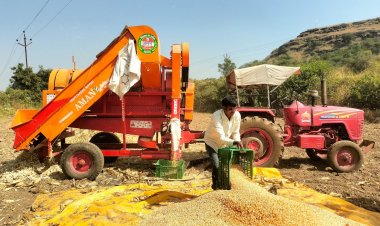Bleak possibilities of resumption of wheat exports
The possibilities of resumption of wheat exports seem to be practically very bleak. And there are two reasons for this. One, the wheat prices in the country had softened somewhat after the prohibition of exports but are now running at Rs 200-Rs 300 per quintal above MSP. The current prices are Rs 2,250-Rs 2,300 per quintal while the MSP of wheat for RMS 2022-23 is Rs 2,015 per quintal. Two, countries criticizing India’s decision to prohibit exports and organizations like the WTO are coming directly in the way of exports to other countries.

When the government on 13 May 2022 prohibited wheat exports from the country, it signalled only days later that India could export wheat to the countries in need. But about 40 days have passed and there are no signs of resumption of wheat exports. Neither has the government taken any policy step in this direction.
In fact, the possibilities of resumption of wheat exports seem to be practically very bleak. And there are two reasons for this. One, the wheat prices in the country had softened somewhat after the prohibition of exports but are now running at Rs 200-Rs 300 per quintal above the Minimum Support Price (MSP). The current prices are Rs 2,250-Rs 2,300 per quintal while the MSP of wheat for the Rabi Marketing Season (RMS) 2022-23 is Rs 2,015 per quintal. Two, countries criticizing India’s decision to prohibit exports and organizations like the World Trade Organization (WTO) are coming directly in the way of exports to other countries.
The reason why the government prohibited wheat exports was to curb the prices in the domestic market. Besides, the fear of an availability crisis in the domestic market due to exports was another reason. A senior official of a company that buys wheat for exports told Rural Voice that the prices had gone down after the export ban but have risen once again. “We had purchased wheat at Rs 2,250 per quintal. It appears from a look at the current prices that even if we have to sell this wheat in the domestic market in the event of not obtaining permission for exports, we will perhaps not have to bear any loss.”
Also, exporting wheat directly to the countries in need does not seem to be possible. Countries in WTO opposed to this stand of India say that if wheat has to be exported to countries in need, this should be done under the World Food Programme (WFP). A member of the United Nations (UN) family, WFP is governed by an Executive Board consisting of 36 Member States. The organization is headed by an Executive Director, who is appointed jointly by the UN Secretary-General and the Director-General of the Food and Agriculture Organization (FAO) of the UN. Under WFP, food is given free to countries that do not have the economic potential to buy it. It is obvious how much price will be paid for wheat exported through this route and how the stocks of the private companies will be exported under this programme. Bangladesh, Indonesia and the Gulf countries are among the major importers of wheat from India but they do not fall under the category of countries importing foodgrains for free because they can afford to pay for the imported foodgrains. Thus, the WFP provision comes as a major challenge to the possibility of direct exports.
The way the government has decided to regulate the exports of wheat products indicates that the government is not much convinced about the availability of wheat in the domestic market. The government and the experts are still divided on the figures for wheat production. The former still maintains that the production for the 2021-22 Rabi season is estimated at 10.6 crore tonnes even as some of the government officials themselves admit to Rural Voice in informal talks that the production will be about 10 crore tonnes. Some of the experts are, however, sceptical of reaching even this mark.
The decline in production has led to the procurement of only 187.42 lakh tonnes (lt) of wheat in the government procurement season 2022-23. This is the figure available on the Central Foodgrain Procurement Portal (CFPP). According to the Food Corporation of India (FCI), 186.57 lt of wheat had been procured till May 30. Last year for RMS 2021-22, the public procurement of wheat stood at 433.44 lt. The procurement level this year is at a 15-year low.
It has happened for the first time that the stocks remaining in the central pool on April 1 are lower than the procurement for the new season. The wheat stocks stood at 189.9 lt in the central pool on Apr 1 this year. Again, the wheat stocks in the central pool on June 1 are at a 14-year low after 2008, when these had been 241.23 lt. According to FCI, the stocks stood at 311.42 lt on June 1 this year while these had been 602.91 lt on the same date a year ago. The June 1 figures happen to be the peak stock of wheat in the central pool every year.
Last year, in 2021-22, India exported 72.39 lt of wheat. The average export price was $293 per tonne and the total export price $2,121.79mn. In 2020-21, India exported 20.88 lt of wheat worth $549.70mn. The average export price stood at $263 per tonne. In the current year 2022-23, on the other hand, India exported 14.73 lt of wheat worth $473mn in the first month of April alone. The average export price was $322 per tonne. The government imposed a prohibition on exports on May 13, so the actual exports, including those for May, should be higher than the figure given above.
Wheat prices have gone up quite high due to a nearly 25 per cent reduction in wheat supply in the global market as a result of the war between Russia and Ukraine that started in February. And this is what led to a surge in wheat exports from India. But the government prohibited wheat exports on May 13. A government official told Rural Voice that the reason behind this move was to curb the domestic prices because apart from providing better prices to the farmers, we also have to protect our domestic consumers from the massive increase in prices in the global market. This has been kept in mind in the government’s decision-making.
In view of the prevailing circumstances, the possibilities of resumption of exports are bleak despite the high prices in the global market, because had the production been as per the government figures, the public procurement would not have stuck at a 15-year low and the peak stock in the central pool on June 1 would not have been at a 14-year low. Besides, the prices remaining Rs 200-Rs 300 higher than MSP despite the prohibition of exports indicates that the prices may remain high in the future, too. Given this situation, the government won’t want the greed for exports to lead to a surge in domestic prices.



 Join the RuralVoice whatsapp group
Join the RuralVoice whatsapp group






































